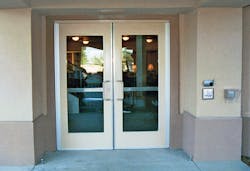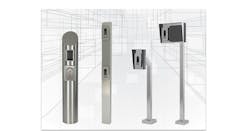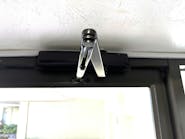Aluminum glass stile doors are used for exterior applications to provide as much light and visibility as possible. In a way, the aesthetically pleasing glass panel doors are an invitation to enter. This may be one of the reasons why these storefront doors are used as entry doors for many restaurants, banks, jewelry stores, markets, movie theatres, post offices, dry cleaners, medical facilities, senior housing and strip malls. The narrow stile aluminum glass doors are just about everywhere, even in four-season climates.
An aluminum glass stile door has two vertical stiles and two rails surrounding the glass panel. The stiles are available in the following three basic width ranges
- Narrow stile: 2 inches
- Medium stile: 3 1/2 inches
- Wide stile: 5 inches
These measurements are for the outer extrusion portion only, the portion that contains the door hardware. This does not include the portion of the stile that retains the glass.
Regardless of the stile width, storefront door lock hardware can be used in most doors. However, it is important to order the correct backset to accommodate the stile width. The lock cylinder backset determines the minimum stile width. For example, the Adams Rite style pivoting deadlock is available in three cylinder backsets: 31/32”, 1-1/8” or 1-1/2”. A 1-1/2" backset deadlock actually has a 2.25" wide body to accommodate the mortise cylinder. This depth requirement will not accommodate a narrow stile.
Pivots vs Hinges
Storefront aluminum glass doors are available as swinging, sliding and telescoping. Swinging doors can be installed using pivots, continuous or butt hinges. Center hung pivots are double acting; these doors can swing in both directions. Butt hinges, continuous hinges and offset pivots are single acting; doors equipped with these devices can swing in only one direction. Like butt hinges, single acting pivots have the spindle or knuckle mounted on the exposed portion of the door. Offset pivots are usually mounted onto an in floor door check (closer).
Pivots provide a more efficient method of door operation because the weight of the door is supported entirely on the bottom pivot arm, which is directly connected to the pivot spindle. A pivot spreads the weight out throughout the entire pivot, enabling pivots to support heavy doors without adding additional stress to the jamb. Top and middle pivots keep the door in position.
Another advantage of pivots over butt hinges is adjustability. Most pivots can be adjusted in order to keep the door swinging as smoothly as possible.
Butt hinges attach the door edge to the frame at three or four connection points. The top hinge (connection point) receives the greatest amount of pressure as gravity pulls down and away on the swing edge of the door. Butt hinges are less expensive and have a commonality in size, making them easily interchangeable.
Door Check
Depending upon the construction, storefront doors can be equipped with a concealed door check in the floor or in the header, or a surface mounted door closer. Concealed door checks provide invisible door control; no portion of the door check is visible when the door is closed.
Concealed door checks, especially floor mounted units, can be expensive and require more maintenance. Conversion kits provide an alternative. These kits convert specific makes, models of center hung and offset pivot floor and overhead mounted concealed door checks to surface mount. The kits actually neutralize the operation of the floor or overhead concealed check to perform as a pivot. A different arm is part of the kit. Note: On center hung door checks, the kit changes the door from double-acting to single-acting.
Power Door Operators
Power door operators provide unencumbered access for the elderly and those individuals who are physically challenged. A low power operator can also be used on openings that must meet opening and closing force code limitations. Always match the features of the low power door operator with those features required by the end user.
Locks
Securing a narrow stile aluminum glass storefront door can be accomplished mechanically and electromechanically. The Adams Rite Pivoting Deadlock has been securing storefront doors with a 1-3/8" throw providing a high degree of security during non-business hours for more than 50 years. Today's models are usually made of laminated steel. The long pivoting throw compensates for the occasional large gap between the door and the jamb or second door.
On storefront doors, if there are two mortise locks extending from the exterior swing stile, the likelihood is the door is equipped with a pivoting deadlock and a deadlatch and/or exit device. The Adams Rite MS1850 Pivoting Deadlock has been private labeled by a number of narrow stile aluminum door products manufacturers.
Over the years, Adams Rite and other lock manufacturers have introduced a number of mechanical locks, electromechanical locks and electric strikes specifically designed for aluminum glass storefront doors.
For example, a double door aluminum glass stile entry on a museum building has interesting locking configurations. The mechanical locks on each door are bottom rail floor bolt locks. These locks can be locked during non-business hours only. For electronic locking, a keypad on the exterior operates an electromagnetic lock for each door. Should there be a problem with the keypad, a mechanical override cylinder will cut the power to the electromagnetic locks during an emergency, unlocking the doors. Handles are mounted on each side of the doors.
Surface-Mount Electric Strikes
The development of the surface mount electric strike can provide an easier installation of an electrified release mechanism for a rim exit device. Release mechanisms can also include electrified trim and Electrified Latch Retraction (pullback). Electric strikes are mounted onto the jamb, where electrified trim and ELR are mounted onto the door with ELR's installed into the case of pushpad exit devices.
Both door-mounted mechanisms require a form of power transfer from the hinge side jamb into the door stile. The Securitron PowerJump uses magnetic inductive coupling to transfer power across the door gap. The power pathway requires no wires. It can be installed onto either jamb or the header and the receiving unit mounted into the door eliminating the need to through core a door or run a wire between the jamb and stile/rail.
As an alternative, a surface mounted electric strike can provide remote release by having the locking mechanism on the swing side jamb. Most surface-mounted electric strikes do not require creating an opening in the aluminum jamb, so installation time is shorter. No-cut surface mounted electric strikes for rim exit device manufacturers include but are not limited to BEA, DORMA, HES, RCI, Rofu, Trine and Allegion.
Latch, Cylinder, Strike Protectors
Latch protectors, latch and lock cylinder protectors and strike protectors increase the level of security for the mechanical lock mechanism. The latch protectors cover the opening between the door edge and the jamb, limiting access to the latch or bolt. Protection plates are available in different configurations to accommodate the mounting location of the door; flush, partial recess or center hung.
One strike protector is a bent piece of metal that is riveted onto the jamb, having an opening to correspond with the lock mechanism. The Adams Rite MS4002 Armored Strike has a steel doubler installed behind the jamb face centered onto the strike. The steel doubler is designed to prevent jamb peeling. As an alternative, a business installed a roll-up door in front of the double door entry.
For double door applications, removable mullions can provide the ability to increase the level of security by incorporating two rim exit devices. The removable mullion keeps the door from being forced and provides center locking using the rim exit devices.
When servicing narrow, medium and wide stile aluminum doors, consider the threshold as well as the door slide-in weather stripping to prevent moisture, insects and dust from entering. Air infiltration increases heating and cooling costs.
When working on narrow stile aluminum glass doors and jambs, make sure hat you are working with aluminum, not metal. Even though aluminum doors are made of thicker material than metal, aluminum does not have the same strength as hollow metal doors. When installing a surface mounted door closer, exit device or similar products, consider through bolting or reinforcing plates to ensure solid mounting.
For More Information
Manufacturers mentioned in this article include:
- Adams Rite: www.adamsrite.com
- BEA: www.beainc.com
- DORMA: www.dorma.com
- HES: www.hesinnovations.com
- National Door Controls: www.replacedoorcloser.com
- RCI: www.rutherfordcontrols.com
- Rofu: www.rofu.com
- Trine: www.trineonline.com
- Allegion: www.allegion.com






